“We need a new elementary math program.” This was my directive on the day I began my new role as the district’s K-12 math supervisor in July of 2012. A few weeks into the position, I did three things: devised an action plan, formed a committee that included teachers of grades K-12, special education, and basic skills, as well as our Elementary Education Supervisor, our Director of Curriculum and Instruction, our elementary school principals, and myself, and began studying the K-5 standards carefully.
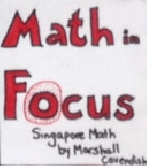
Passionate about the Common Core and recognizing the need to address both the practice and content standards in every classroom, every day, I knew we needed to find a program that would serve as the teachers’ primary instructional resource and would address this need.
After examining several different programs, the committee recommendation was to adopt Math in Focus: Singapore Math. We implemented Math in Focus in grades K-2 in the fall of 2013, while piloting lessons and units in grades 3-5 that same year. In the fall of 2014, we fully implemented the program in grades 3-5.
Throughout the selection process, the focus on the standards was critically important. It was reflected in our instructional materials evaluation rubric, which was utilized both during vendor presentations and when the programs were examined in-person at site visits.
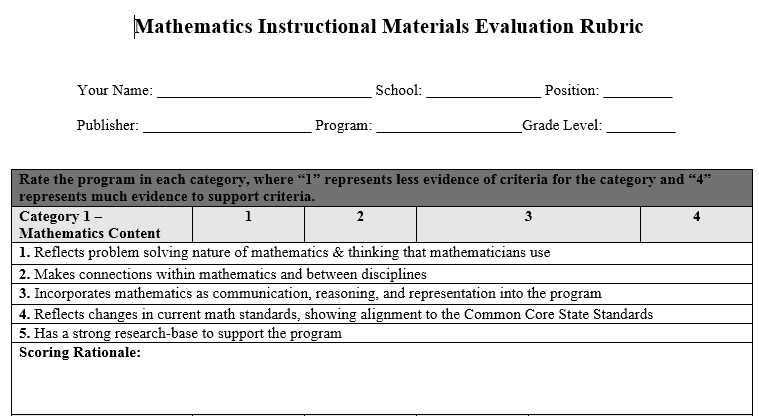
Following two site visits, it was clear Math in Focus was rated favorably by the committee members, particularly in the area of mathematics content. Teachers made comments such as “bar modeling is a wow factor for me [as it leads] to deeper understanding;” “[the] concrete to pictorial to abstract idea aligns to [the] Common Core,” and “students are asked to communicate reasoning.”

One teacher recognized what we later came to understand as a strength and weakness of this program: “I felt that students had internalized what the math meant and were doing higher level work in younger grades.”
From a strength perspective, Math in Focus reaches a far greater depth of understanding than our traditional math program which had previously been used for over ten years. Math in Focus emphasizes the pedagogical approach of the concrete, pictorial, and abstract stages of learning, as well as problem solving and the use of number bonds and bar models as visual representations.
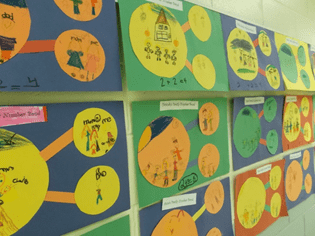
While it was a strength that our students were now engaged in challenging mathematical work, the content of the program in various grade levels was above the grade-level content standards, which challenged our implementation plans. It also challenged us to structure our curriculum in a way that would ensure students were meeting grade-level standards and had enough time devoted to the Major Work of the Grade.
While each grade-level textbook did “focus more strongly where the standards focus,” we found the need to allocate additional time to the Major Work of the Grade. Careful thought was required to maintain coherence despite the adjustments we made to the curriculum to achieve this goal.
Each spring for three consecutive years, I met with grade-level teacher representatives from each building to do this work. We carefully examined our curriculum and determined the sequencing, movement, and elimination of units and lessons to ensure Coherence and Focus. This was no easy task. Any time we changed the sequence, we had to be mindful of prerequisite knowledge assumed in certain problems. When we eliminated lessons or units, it would then fall to the subsequent grade level to incorporate said lessons into their curriculum.

Because we used the 2013 edition of the program, we also needed to carefully examine and incorporate the Common Core Focus Lessons, which at the time were provided as supplemental lessons in the back of the teacher’s editions. These were designed to ensure each content standard of the grade was addressed.
After three years of adjustment and fine tuning we were in a better place. Each year it became easier, and not because we moved one unit here or there. Teachers were more comfortable with the program and with the instructional strategies. They understood the standards more deeply. They embraced the importance of creating an environment for students to be problem solvers. At the conclusion of our fourth year of implementation, math performance on the PARCC assessment increased in every single grade level and cohort in the district from the previous year.
While EdReports did not have a favorable review of Math in Focus as it relates to Focus and Coherence, and thus did not review the series for alignment in terms of Rigor and the Mathematical Practices, I knew that, as educational leaders, it was our duty to ensure we had a program that embodied the elements of Rigor: conceptual understanding, fluency, and application. We felt that Math in Focus addressed Rigor well. We could do the rest – ensuring Coherence and Focus through regular review of the curriculum, providing high-quality professional development, and making sure our students were meeting grade-level standards.
It is important for districts examining math programs to understand the textbook should not serve as the curriculum. It may serve as the primary instructional resource, but the focus needs to be on writing a curriculum aligned to the standards. This means we cannot accept opening up to page one in the teacher’s guide and teaching page by page.
In fact, Math in Focus typically has as many as 175 days of instruction outlined in any one of the textbook’s pacing guides. We know there are never 175 teaching days in elementary school after all assemblies, field trips, and standardized testing are accounted for. It is important to take time in groups to carefully examine the materials and continue to reflect on what the standards dictate we emphasize.
Beyond the textbook, teachers are encouraged to use the online resources available on Think Central, the online platform for Houghton Mifflin. Included is the student workbook, student edition, virtual manipulatives, student interactives, and parent support videos, to name a few. Teachers were also encouraged to make use of other resources to supplement their instruction, such as Illustrative Mathematics for their rich instructional and assessment tasks, National Library of Virtual Manipulatives for their online, interactive manipulatives, Illuminations for their lesson plans and interactives, and Thinking Blocks for practice with creating models to represent problems.
Ongoing conversation between teachers, both within and across grade levels, was also important to ensure coherence and high-quality professional development. We held regular articulation meetings for teachers to discuss and share information about the linking of topics across grade levels.
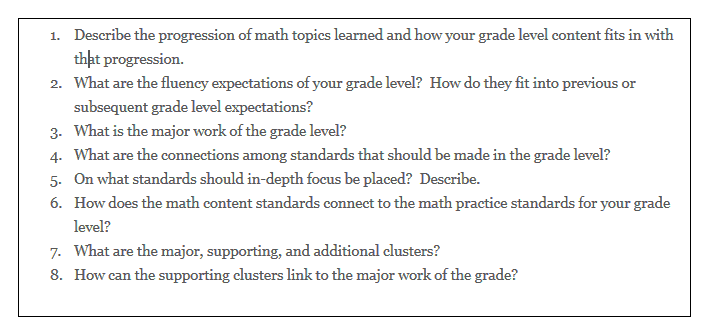
The implementation plan for Math in Focus also included ongoing professional development provided by Houghton Mifflin’s professional development team, Bill Jackson, Makoto Yoshida from East-West Math, Nancy Schultz from Conquer Mathematics, and myself. We gave careful thought to the teachers’ needs when planning customized professional development.
Elementary lesson study teams were also formed in our third and fourth years of implementation. We conducted each lesson study as an open house so other districts that were either also conducting lesson study or were interested in starting lesson study in their district were able to observe and participate in the process.

The importance of high-quality professional development and instructional leadership within the district is critically important to successful implementation of any math program.
While no program will be perfect as packaged, what we created with the use of Math in Focus met our needs, pushed us all to learn, and left us in a much better place than where we started.


















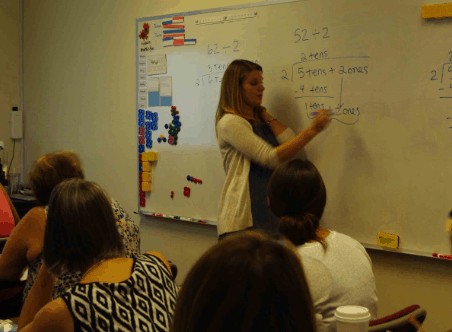


What about assessments? Did you modify them or use the MiF assessments as is?
Looking at assessments and aligning them with a standards-based report card was next on the list.
Great information,That are given in this article,Thanks for posting this type of information.
Would you be able to share your full pacing guide across grade levels? This is the exact problem we are having at my school.
I would also be interested in seeing your pacing guides, but I did not see your email to contact you. Would you mind posting your email please? Thanks so much!
I would love the pacing guide please.
Hi!
Is it possible to see your pacing guide? We’ve been having a lot of trouble putting one together – lack of resources amongst other things! It would be a huge help!
Could you please send me your pacing guide? Thank you!
Kathy, I too would love to see your pacing guide. Thank you for sharing your honest insights!
I would like to see your pacing guide and also the full rubric you used to evaluate the math curriculums.
I would also love the pacing guide! Such a fabulous publication!
I am looking for something with the SM:MIF curriculum that correlates the CC standards to the objectives for each lesson. The MIF site does not provide such a resource, and the textbook has the standards correlated to the page numbers, but I want to see a table that has the standard and the objectives connected. Anyone seen that anywhere?
Thank you for this valuable information. I am in the Somerset Hills School District, where we use Math in Focus and we are also working to improve the pacing of instruction, and align to NJSLS. Would you be willing to share your pacing guide?
Thanks so much,
Laurie
Would you be willing to share your pacing guides through gmail or email?
Can you send me your pacing guide for Math in Focus?
Thank you for the information! It is very helpful. I too would appreciate seeing your pacing guide for grade 5.
Hello, I am looking for 3rd Grade MIF workbook answer key. Please anybody can email me at samina_ghumman786@hotmail.com
Can I please have a copy of the grade 3 pacing guide and the list to supplement for Math in Focus.
Thank you for the thorough review! I, too, would love to see a copy of your revised pacing guides. Keep up the great work!
Hello! Your pacing guide looks great. I’m in my second year teaching Math in Focus. We are starting online so I am adjusting my pacing guide to ensure we only hit 4th grade standards, we typically cover the full book. Do you have a tpt link where I could purchase your pacing guide, or an email would be great! Thank you so much!
would you be willing to share your pacing guide for grade 5? Many thanks
I would appreciate hearing from 7th & 8th grade teachers who use Math in Focus.
Opinions, pros and cons of the program, pacing guides, assessments etc?
Thank You,
Bill
I would love to see your pacing guide. Thank you!